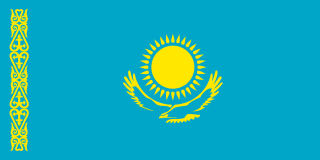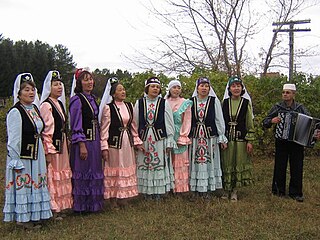
The Volga Tatars of Kazakhstan or Tatar Kazakhstanis are a minority in Kazakhstan, and make up 1.5% of the population. There are 249,000 Volga Tatars living in Kazakhstan accordingly to 1999 census (see Demographics of Kazakhstan).

The Volga Tatars of Kazakhstan or Tatar Kazakhstanis are a minority in Kazakhstan, and make up 1.5% of the population. There are 249,000 Volga Tatars living in Kazakhstan accordingly to 1999 census (see Demographics of Kazakhstan).
Volga Tatars have penetrated the area that is today Kazakhstan from the nineteenth century, entering the region as traders offering manufactured goods to nomadic Kazakhs. They were also Islamic missionaries, and Tatar settlers were the conduit of Islam into the region.
Volga Tatars became well assimilated in Kazakhstani society. During the Soviet period many Tatars occupied positions in the medium-level administration and they comprised a significant part of the Kazakhstani intelligentsia.
Now each Kazakhstan oblast has its own Tatar cultural centre, dedicated to preserve ethnic identity. According to 2009 national census 79.5% of Tatar Kazakhstanis identify as Muslims, and 10.2% as Christians and 8.1% as Atheists.

Kazakhstan, officially the Republic of Kazakhstan, is a landlocked country primarily in Central Asia, with a small portion situated in Eastern Europe. It borders Russia to the north and west, China to the east, Kyrgyzstan to the southeast, Uzbekistan to the south, and Turkmenistan to the southwest, with a coastline along the Caspian Sea. Its capital is Astana, while the largest city and leading cultural and commercial hub is Almaty.

The Tatars, formerly also spelled Tartars, is an umbrella term for different Turkic ethnic groups bearing the name "Tatar" across Eastern Europe and Asia.

Tatarstan, officially the Republic of Tatarstan, sometimes also called Tataria, is a republic of Russia located in Eastern Europe. It is a part of the Volga Federal District; and its capital and largest city is Kazan, an important cultural centre in Russia. The region's main source of wealth is oil with a strong petrochemical industry.

The Bashkirs or Bashkorts are a Turkic ethnic group indigenous to Russia. They are concentrated in Bashkortostan, a republic of the Russian Federation and in the broader historical region of Badzhgard, which spans both sides of the Ural Mountains, where Eastern Europe meets North Asia. Smaller communities of Bashkirs also live in the Republic of Tatarstan, the oblasts of Perm Krai, Chelyabinsk, Orenburg, Tyumen, Sverdlovsk and Kurgan and other regions in Russia; sizeable minorities exist in Kazakhstan and Uzbekistan.

The Kazakh Soviet Socialist Republic, also known as Soviet Kazakhstan, the Kazakh SSR, KaSSR, or simply Kazakhstan, was one of the transcontinental constituent republics of the Soviet Union (USSR) from 1936 to 1991. Located in northern Central Asia, it was created on 5 December 1936 from the Kazakh ASSR, an autonomous republic of the Russian SFSR.

The Chuvash people are a Turkic ethnic group, a branch of the Oğurs, inhabiting an area stretching from the Idel-Ural region to Siberia.

Idel-Ural, literally Volga-Ural, is a historical region in Eastern Europe, in what is today Russia. The name literally means Volga-Urals in the Tatar language. The frequently used Russian variant is Volgo-Uralye. The term Idel-Ural is often used to designate 6 republics of Russia of this region: Bashkortostan, Chuvashia, Mari El, Mordovia, Tatarstan and Udmurtia, especially in Tatar-language literature or in the context of minority languages.

Islam is a major religious minority in the Russian Federation, which has the largest Muslim population in Europe. According to the US Department of State in 2017, Muslims in Russia numbered 14 million or roughly 10% of the total population. One of the Grand Muftis of Russia, sheikh Rawil Gaynetdin, estimated the Muslim population of Russia at 25 million in 2018.

Siberian Tatars or Sibirs are the indigenous Turkic-speaking population of the forests and steppes of Western Siberia, originating in areas stretching from somewhat east of the Ural Mountains to the Yenisey River in Russia. The Siberian Tatars call themselves Yerle Qalıq, to distinguish themselves from more recent Volga Tatar immigrants to the region.
The Mongol invasion of Volga Bulgaria lasted from 1223 to 1236. The Bulgar state, centered in lower Volga and Kama, was the center of the fur trade in Eurasia throughout most of its history. Before the Mongol conquest, Russians of Novgorod and Vladimir repeatedly looted and attacked the area, thereby weakening the Bulgar state's economy and military power. The latter ambushed the Mongols in the later 1223 or in 1224. Several clashes occurred between 1229–1234, and the Mongol Empire conquered the Bulgars in 1236.

The Germans of Kazakhstan are a minority in Kazakhstan, and make up a small percentage of the population. Today they live mostly in the northeastern part of the country between the cities of Astana and Oskemen, the majority being urban dwellers.

The Volga Tatars or simply Tatars, and occasionally by the historical Turko-Tatars, are a Kipchak-Bulgar Turkic ethnic group native to the Volga-Ural region of western Russia. They are subdivided into various subgroups. Volga Tatars are the second-largest ethnic group in Russia after ethnic Russians. Most of them live in the republics of Tatarstan and Bashkortostan. Their native language is Tatar, a language of the Turkic language family. The predominant religion is Sunni Islam, followed by Orthodox Christianity.

Islam is the second-largest religion in Europe after Christianity. Although the majority of Muslim communities in Western Europe formed as a result of immigration, there are centuries-old indigenous European Muslim communities in the Balkans, Caucasus, Crimea, and Volga region. The term "Muslim Europe" is used to refer to the Muslim-majority countries in the Balkans and the Caucasus and parts of countries in Eastern Europe with sizable Muslim minorities that constitute large populations of indigenous European Muslims, although the majority are secular.

Christianity in Kazakhstan is the second most practiced religion after Islam and one of the major religions of Kazakhstan.

Kryashens are a sub-group of the Volga Tatars, frequently referred to as one of the minority ethnic groups in Russia. They are mostly found in Tatarstan and in Udmurtia, Bashkortostan and Chelyabinsk Oblast.

Kazakhstan is a multiethnic country where the indigenous ethnic group, the Kazakhs, comprise the majority of the population. As of 2024, ethnic Kazakhs are about 71% of the population and ethnic Russians in Kazakhstan in 2024 was about 14.9% in second place. These are the two dominant ethnic groups in the country with a wide array of other groups represented, including Ukrainians, Uzbeks, Germans, Tatars, Chechens, Ingush, Uyghurs, Koreans, and Meskhetian Turks.

The Nogais are a Kipchak people who speak a Turkic language and live in Southeastern Europe, North Caucasus, Volga region, Central Asia and Turkey. Most are found in Northern Dagestan and Stavropol Krai, as well as in Karachay-Cherkessia, Chechnya and Astrakhan Oblast; some also live in Dobruja, Turkey, Kazakhstan, Uzbekistan, Ukraine and a small Nogai diaspora is found in Jordan. They speak the Nogai language and are descendants of various Mongolic and Turkic tribes who formed the Nogai Horde. There are eight main groups of Nogais: the Ak Nogai, the Karagash, the Kuban-Nogai, the Kundraw-Nogai, the Qara-Nogai, the Utars, Bug-Nogai, and the Yurt-Nogai.

The Luhansk Cathedral Mosque is a mosque in Luhansk, Ukraine.

The Mishar Tatars, previously known as the Meshcheryaki (мещеряки), are the second largest subgroup of the Volga Tatars, after the Kazan Tatars. Traditionally, they have inhabited the middle and western side of Volga, including the nowadays Mordovia, Tatarstan, Bashkortostan, Ryazan, Penza, Ulyanovsk, Orenburg, Nizhny Novgorod and Samara regions of Russia. Many have since relocated to Moscow. Mishars also comprise the majority of Finnish Tatars and Tatars living in other Nordic and Baltic countries.
Tatarophobia refers to the fear of, the hatred towards, the demonization of, or the prejudice against people who are generally referred to as Tatars, including but not limited to Volga, Siberian, and Crimean Tatars, although negative attitudes against the latter are by far the most severe, largely as a result of the Soviet media's long-standing practice of only depicting them in a negative way along with its practice of promoting negative stereotypes of them in order to provide a political justification for the deportation and marginalization of them.